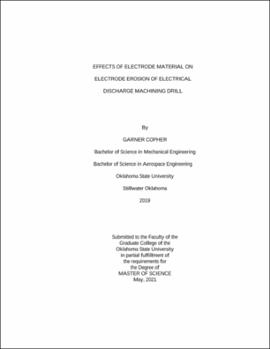| dc.contributor.advisor | Rouser, Kurt | |
| dc.contributor.author | Copher, Garner | |
| dc.date.accessioned | 2021-09-24T13:57:55Z | |
| dc.date.available | 2021-09-24T13:57:55Z | |
| dc.date.issued | 2021-05 | |
| dc.identifier.uri | https://hdl.handle.net/11244/330905 | |
| dc.description.abstract | This paper presents an experimental investigation of the effects of electrode material and workpiece material on electrode wear and performance of a handheld electrical discharge machining drill. In the aerospace maintenance, repair, and overhaul industry, large quantities of high strength fasteners must be removed. These fasteners are difficult to remove and take up a significant amount of time when using traditional methods with mechanical twist drill bits. Electrical discharge machining has become a well-developed technology in the last century, utilizing pulsed electrical arcs to erode target material. Perfect Point EDM has developed a handheld drill configuration of an electrical discharge machining drill named "E-Drill^TM" to speed up the fastener removal process. While the electrical discharge machining process is active, the discharging electrode is eroding along with the target material. Previous work has addressed the erosion process, and erosion prediction algorithms have been developed to aid the machine in estimating cut depth, when to replace the electrode and supply chain management. This current investigation involves experiments with an E-Drill^TM, in which copper and brass electrodes were used to cut into Inconel and titanium alloys to measure and calculate electrode wear and performance parameters. These parameters include cut time, cut rate, electrode volume ratio, and volume removal rate. The brass electrodes consistently produced cut times of 40s to 50s for both workpiece materials as opposed to 145s to 245s for copper. The brass electrode volume ratio, which is the ratio of lost electrode volume to volume of target material removed, was more than twice that of copper for either workpiece material, however, the copper appeared to be affected more drastically by the workpiece material than the brass electrodes. | |
| dc.format | application/pdf | |
| dc.language | en_US | |
| dc.rights | Copyright is held by the author who has granted the Oklahoma State University Library the non-exclusive right to share this material in its institutional repository. Contact Digital Library Services at lib-dls@okstate.edu or 405-744-9161 for the permission policy on the use, reproduction or distribution of this material. | |
| dc.title | Effects of electrode material on electrode erosion of electrical discharge machining drill | |
| dc.contributor.committeeMember | Harimkar, Sandip | |
| dc.contributor.committeeMember | Jacob, Jamey | |
| osu.filename | copher_okstate_0664M_17205.pdf | |
| osu.accesstype | Open Access | |
| dc.type.genre | Thesis | |
| dc.type.material | Text | |
| dc.subject.keywords | edm hand drill | |
| dc.subject.keywords | electrode wear | |
| dc.subject.keywords | material properties | |
| thesis.degree.discipline | Mechanical and Aerospace Engineering | |
| thesis.degree.grantor | Oklahoma State University | |
